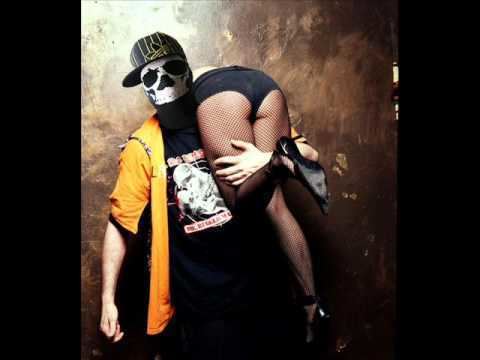Also known as Roffe the Ruffler Years active 2007/2009–2013 Name Roffe Ruff | Labels Stiladig.nu Role Musical Artist | |
Occupation(s) Singer, songwriter, record producer Albums Panterparken, Barrabas, Ormar i graset, Bootlegs Similar People Hofmastarn, Organism 12, Daltone, Kapten Rod, DC Grimsta Profiles | ||
Roffe Ruff & Hofmästarn - Kan inte se det
Roffe Ruff is a Swedish hip hop and ragga artist and music producer from Gothenburg. His real identity remains a secret, and he always wears a skull mask in his appearances.
Contents
- Roffe Ruff Hofmstarn Kan inte se det
- Roffe Ruff 14 Screenprint
- Biography
- Musical style
- Discography
- Songs
- References

Roffe Ruff 14 - Screenprint
Biography
Roffe Ruff was raised in Majorna, the district in Gothenburg that receives most performing royalties from STIM—the Swedish collecting society. He played in his first band at the age of twelve, and recorded rap songs on a DAT recorder together with a friend when he was seventeen. They made a go for it in the music business three years later and Roffe loved the feeling to be on stage, but hated the feeling after a gig, as he felt self-contempt over the fact that his stage personality—that emanated confidence—was a lie not reflecting the real him.

His first appearance as a solo artist (under the name Roffe the Ruffler), after several years in different bands, came in 2007 when he was offered to record a single for the hit disc Mr. Gillis Reggaepropaganda vol. 2. He sent a card of himself disguised with a skull mask for the cover, the future trademark appearance of Roffe Ruff. He was fired from his job not long after, unrightfully and against Swedish labour law according to himself. His frustration and vindictiveness was vented in his first album Ormar i graset that was released in 2009. The album was published on his website, downloadable free of charge. Roffe Ruff states that due to the lack of fair ways for artists to make money on their music, he chooses to "fool everyone including myself on the profits". The anonymous release of his music was a liberation, there were no expectations on him and for the first time he could look himself in the mirror without being ashamed of the music. People also seemed to concentrate more on the music and less on the person, allowing people to interpret his music more freely.
As Ormar i graset was released uncontrolled there are no sales statistics, but the songs from the album have been played over 450,000 times on YouTube—around 100,000 plays more than the songs from Joakim Thastrom's Karlek ar for dom, the Swedish Grammy Award album for 2009—and Roffe Ruff was observed in a much wider sphere than he anticipated. The next project, Panterparken EP, a cooperation with his friend and colleague Hofmastarn, was originally meant to be a short four-track EP but was expanded to nine tracks in the end. It was released in 2010, and was made available free of charge by Roffe Ruff on for example The Pirate Bay.
The anonymity created by the mask and the artist name—that at first seemed to have solved his lifelong dilemma—soon became a burden when the interest for the man behind the mask was spurred by the mysterious and withdrawn personality. Since Roffe Ruff and his childhood friend sent merchandise from the address where their secret studio was located, unthoughtful in retrospect, more and more people in his neighbourhood figured out the real identity. On New Year's Day 2010 the studio was subject to a burglary, and even one of the policemen who was sent to the crime scene had figured out that Roffe Ruff was one of the victims. A big fan of the artist that has recorded the song Snutsvin ("cop pig"), the policeman asked if he could get a hold of a Roffe Ruff shirt anywhere.
Being exposed in just the way he did not want to be, Roffe Ruff's third album Barrabas released in 2011—downloadable for free just as the previous ones. For the first time the songs are about his anonymity, stating that "when I made my previous album I was so naive, I though I was in control of myself and my life. I know now that I was wrong, and that is why I am quitting now. But first I have to do an album that speaks for itself."
2013 the latest album called Bootlegs was released. The album contains 17 tracks recorded together with Rico Won, Snacka San, Hofmastarn, Daltone, Tommy Tip, Organismen. The album contains new and previous released songs at YouTube.
Musical style
Roffe Ruff's albums are a mix of Swedish hip hop, reggae, ragga and dancehall. The atmosphere is mostly dark and the lyric themes include police harassment, criticism of various community institutions, old memories, alienation, depression, social class and consolation drinking. Some of his early songs were created by adding his own texts over the beat of well-known English-speaking artists' productions, such as Chamillionaire's Day dream (became Snutsvin) and Estelle's and Kanye West's American Boy (became Majornapojk), while his last album Barrabas consisted entirely of new productions.
Discography
Songs
Snutsvin
Internet Gangsta
Ormar i graset
Barrabas
Battre pa botten blues
Psykofarmakajesus
Ingen Karlek
Pa lokal
Vill inte langre
Solen forsvann
Vilken tur anda
Morda dom
Skyll pa mig
Dramastan
Inga gudar
Ge mig ett skal
Jag hor dig snacka tjabo
I Roffes barndom
En trappa ner
Froken Anderberg
Manodepressiv
Farval
Sa ar det
17 nov
Skit
93
LIMBO
Intro
Prolog
Ett glas ol
Jag ar din
Monster
